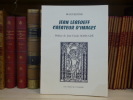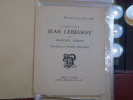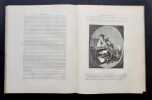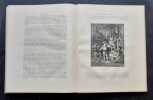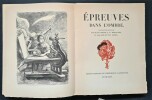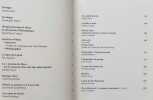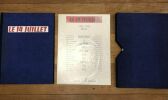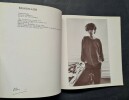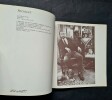50000 books for « sur jean »Edit
-
Latest
Last 24h (90)
Last 3 days (87)
Last month (5423)
Last week (344)
-
Language
Albanian (1)
Dutch (57)
English (80)
French (234161)
German (19)
Greek (13)
Italian (10)
Japanese (1)
Latin (29)
Portuguese (1)
Romanian (2)
Russian (80)
Spanish (14)
Swedish (1)
-
Century
16th (187)
17th (685)
18th (3102)
19th (6434)
20th (117675)
21st (23239)
-
Countries
Belgium (10117)
Brazil (14)
Canada (1610)
China (160)
Côte d'Ivoire (198)
Denmark (343)
France (207704)
Germany (501)
Greece (102)
Italy (182)
Netherlands (3)
Switzerland (13416)
United Kingdom (38)
United States of America (81)
-
Syndicate
ALAC (1383)
CLAM (581)
CLAQ (395)
CNE (184)
ILAB (105534)
NVVA (1708)
SLACES (1706)
SLAM (100274)
SNCAO (506)
Type
- Any type (7)
- Art print (2)
- Artists book (11)
- Autograph (29)
- Book (228116)
- Disk (45)
- Drawings (25)
- Engraving (249)
- Magazine (560)
- Manuscript (19)
- Maps (220)
- Music sheets (4953)
- New book (26)
- Old papers (28)
- Photographs (119)
- Postcards (17)
- Posters (42)
- Public sale (1)
Topics
- Algeria (583)
- Alsace (937)
- Anouilh jean (693)
- Aquitaine (1125)
- Archaeology (1183)
- Architecture (1482)
- Army (524)
- Autographs (2004)
- Belgium (698)
- Bibliophilism (666)
- Biography (2609)
- Brittany (1067)
- Bruce jean (584)
- Catholicism (567)
- Children’s books (2217)
- China (500)
- Christianity (1193)
- Christmas (557)
- Cinema (1246)
- Cocteau jean (2030)
- Comic strip (2341)
- Cooking (1011)
- Dedication (2138)
- Detective novels (781)
- Dictionaries (575)
- Drawings (1056)
- Dutourd jean (572)
- Early printed books (820)
- Economics (1385)
- Education (1203)
- Education - morals (710)
- Esotericism (664)
- Essays (592)
- Ethnology (515)
- Fine arts (2288)
- First edition (4823)
- French literature (665)
- Genealogy (839)
- Genet jean (493)
- Geography (2035)
- Giono jean (630)
- Giraudoux jean (889)
- Guide books (637)
- Helvética (1648)
- History (10696)
- Humour anecdotes (1012)
- Illustrated books (631)
- Industrial arts & crafts - fine arts (1030)
- John-paul ii (958)
- Journalism (656)
- Law (1802)
- Linnean society of lyons (483)
- Literature (22591)
- Lorrain (1054)
- Magazine (1632)
- Manuscripts (580)
- Medicine (2123)
- Middle ages (563)
- Military arts (569)
- Music (765)
- Napoleon i (674)
- Navy (1417)
- Newspapers press (2577)
- Normandy (508)
- Painters (579)
- Painting (1119)
- Paris (1943)
- Philosophy (3474)
- Photography (1658)
- Poetry (4494)
- Policy (2271)
- Provence (914)
- Psychology (1711)
- Racine jean (834)
- Regionalism (2540)
- Religions (2889)
- Review (1945)
- Reviews (2439)
- Rousseau jean jacques (1211)
- Sartre jean paul (1237)
- Sciences (1315)
- Scores (5220)
- Social sciences (597)
- Sociology (924)
- Songs (4732)
- Sports (543)
- Switzerland (1928)
- Tales (673)
- Tharaud jérôme et jean (511)
- Theatre (3042)
- Theology (1411)
- Travel (933)
- Various (1830)
- Waltz (525)
- War (2586)
- Youth (652)
Jean LEBEDEFF créateur d'images.
Aux Folies De L'Ymaigier Nîmes 1984 In-4 ( 280 X 210 mm ) de 97 pages, broché sous couverture illustrée. Préface de J.-C. MARCADE. Texte de MAGUELONE, pseudonyme de Marie-Claire BLANC, compagne de Jean LEBEDEFF. Plus de 120 gravures sur bois -certaines inédites- dans et hors-texte de Jean LEBEDEFF et 5 planches photographiques. Edition originale au tirage limité à 500 exemplaires numérotés sur Couché Périgord. EXEMPLAIRE UNIQUE, à l'état de neuf, enrichi hors justification:- De la vignette de couverture signée au crayon par Jean LEBEDEFF.- Du tirage de la gravure de la page 1 signé au crayon par Jean LEBEDEFF.- Du tirage de la gravure de la page 3 signé au crayon par Jean LEBEDEFF.- Du tirage de la gravure de la page 5 en 2 états, justifié et signé au crayon par Jean LEBEDEFF.- Du tirage de la gravure de la page 13 signé au crayon par Jean LEBEDEFF.- Du tirage de la gravure de la page 15 en épreuve d'artiste, signé au crayon par Jean LEBEDEFF.- Du tirage de la gravure de la page 17 en 2 états, justifié et signé au crayon par Jean LEBEDEFF.- Du tirage de la gravure de la page 18 signé au crayon par Jean LEBEDEFF.- Du tirage de la gravure de la page 20.- Du tirage de la gravure de la page 21.- Du tirage de la gravure de la page 22 signé au crayon par Jean LEBEDEFF.- Du tirage de la gravure de la page 23.- Du tirage de la gravure de la page 24 signé et justifié au crayon par Jean LEBEDEFF.- Du tirage de la gravure de la page 27 signé au crayon par Jean LEBEDEFF.- Du tirage de la gravure de la page 30, en couleurs, signé et justifié au crayon par Jean LEBEDEFF.- Du tirage de la gravure de la page 38 signé et justifié au crayon par Jean LEBEDEFF.- Du tirage de la gravure de la page 43 signé et justifié au crayon par Jean LEBEDEFF.- Du tirage de la gravure de la page 47 signé et justifié au crayon par Jean LEBEDEFF.- Du tirage de la gravure de la page 48, en couleurs, signé et justifié au crayon par Jean LEBEDEFF.- Du tirage de la gravure de la page 57, en couleurs, signé et justifié au crayon par Jean LEBEDEFF.- Du tirage de la gravure de la page 59 signé et justifié au crayon par Jean LEBEDEFF.- Du tirage de la gravure de la page 61 signé et justifié au crayon par Jean LEBEDEFF ( Epreuve d'Artiste sur Vieux Japon ).- Du tirage de la gravure de la page 62.- Du tirage de la gravure de la page 63.- Du tirage de la gravure de la page 73.- Du tirage de la gravure de la page 74 signé au crayon par Jean LEBEDEFF.- Du tirage de la gravure des pages 76-77 justifié et signé au crayon par Jean LEBEDEFF ( Epreuve d'Artiste ).- Du tirage de la gravure de la page 79 signé et justifié au crayon par Jean LEBEDEFF.- Du tirage de la gravure de la page 81 signé au crayon par Jean LEBEDEFF.- Du tirage de la gravure de la page 82, en couleurs, signé et justifié au crayon par Jean LEBEDEFF ( Epreuve d'Artiste ).- Du tirage de la gravure de la page 85, en couleurs, signé et justifié au crayon par Jean LEBEDEFF ( Epreuve d'Artiste ).- Du tirage de la gravure de la page 87 signé au crayon par Jean LEBEDEFF.- Du tirage de la gravure de la page 88, signé et justifié au crayon par Jean LEBEDEFF ( Epreuve d'Artiste ).- Du tirage de la gravure de la page 89, signé et justifié au crayon par Jean LEBEDEFF ( Epreuve d'Artiste ).- Du tirage de la gravure de la page 89, signé au crayon par Jean LEBEDEFF.- Du tirage de la gravure de la page 91, en couleurs, signé et justifié au crayon par Jean LEBEDEFF.- Du tirage de la gravure de la page 92, signé au crayon par Jean LEBEDEFF.- Du tirage de la gravure de la page 93, signé et justifié au crayon par Jean LEBEDEFF.Certaines de ces gravures ont des indications techniques de la main de MAGUELONE ou de Jean LEBEDEFF ( placement, format, etc.. ) pour l'établissement de cet ouvrage.-D'une douzaine de gravures sur bois justifiées et signées au crayon par Jean LEBEDEFF. Très bel ensemble.
L'YMAIGIER Jean LEBEDEFF. Présentation de Pierre CHAMPION. Nombreuses compositions originales dessinées et gravées sur bois et catalogue complet de l'oeuvre de l'artiste.
Chez L'Auteur Paris 1939 Petit in-4 carré ( 255 X 205 mm ) de 105 pages, demi-chagrin chocolat à coins, dos à nerfs janséniste avec date dorée en queue, tête dorée, couverture et dos conservés ( Reliure de l'époque ). 85 bois originaux dans et hors-texte de Jean LEBEDEFF. Edition originale et premier tirage de la plupart des bois. 1 des 10 exemplaires numérotés sur Japon Impérial ( N°13 ). EXEMPLAIRE UNIQUE de MAGUELONE femme de Jean LEBEDEFF enrichi hors-justification:- D'un bel envoi autographe signé de l'auteur à Marie-Claire LEBEDEFF, la femme de Jean LEBEDEFF et dédicataire de l'ouvrage. Et dans un tirage de la couverture en grand format formant pochette:- Du prospectus publicitaire à double-page de présentation de l'ouvrage.- De l'avis de naissance du fils de Jean LEBEDEFF et de MAGUELONE en épreuve d'artiste sur Chine signée au crayon par Jean LEBEDEFF.- De la vignette de couverture signée au crayon par Jean LEBEDEFF.- Du portrait en frontispice justifié et signé au crayon par Jean LEBEDEFF.- Du tirage de la gravure de la page 13 justifié et signé au crayon par Jean LEBEDEFF.- Du tirage de la gravure de la page 15 justifié et signé au crayon par Jean LEBEDEFF.- Du tirage de la gravure de la page 17 en 2 états, noir et couleurs justifié et signé au crayon par Jean LEBEDEFF.- Du tirage de la gravure de la page 21 en épreuve d'artiste en couleurs signé au crayon par Jean LEBEDEFF.- Du tirage de la gravure de la page 23 en 2 états, noir et couleurs signé au crayon par Jean LEBEDEFF.- Du tirage de la gravure de la page 25 signé au crayon par Jean LEBEDEFF.- Du tirage de la gravure de la page 29 en 3 états, réduit, noir et couleurs justifié et signé au crayon par Jean LEBEDEFF.- Du tirage de la gravure de la page 31 en 2 états, noir et couleurs signé au crayon par Jean LEBEDEFF.- Du tirage de la gravure de la page 35 en 2 états, noir et couleurs signé au crayon par Jean LEBEDEFF.- Du tirage de la gravure de la page 37 en 2 états, noir et couleurs signé au crayon par Jean LEBEDEFF.- Du tirage de la gravure de la page 39 en épreuve d'artiste justifié et signé au crayon par Jean LEBEDEFF.- Du tirage de la gravure de la page 41 justifié et signé au crayon par Jean LEBEDEFF.- Du tirage de la gravure de la page 43 en 2 états, noir et couleurs signé au crayon par Jean LEBEDEFF.- Du tirage de la gravure de la page 45 justifié et signé au crayon par Jean LEBEDEFF.- Du tirage de la gravure de la page 47 en 3 états, noir, bistre et couleurs signé au crayon par Jean LEBEDEFF.- Du tirage de la gravure de la page 49 en 2 états, noir et couleurs signé au crayon par Jean LEBEDEFF.- Du tirage de la gravure de la page 51 signé au crayon par Jean LEBEDEFF.- Du tirage de la gravure de la page 55 signé au crayon par Jean LEBEDEFF.- Du tirage de la gravure de la page 59 sur papier fin.- Du tirage de la gravure de la page 61 en couleurs, justifié et signé au crayon par Jean LEBEDEFF.- Du tirage de la gravure de la page 63 signé au crayon par Jean LEBEDEFF.- Du tirage de la gravure de la page 66 signé au crayon par Jean LEBEDEFF.- Du tirage de la gravure de la page 68 en épreuve d'artiste, signé au crayon par Jean LEBEDEFF.- Du tirage de la gravure de la page 71 justifié et signé au crayon par Jean LEBEDEFF.- Du tirage de la gravure de la page 76.- Du tirage de la gravure de la page 77 en épreuve d'artiste signé au crayon par Jean LEBEDEFF.- Du tirage de la gravure de la page 79 justifié et signé au crayon par Jean LEBEDEFF.- Du tirage de la gravure de la page 81 signé au crayon par Jean LEBEDEFF ( 2 exemplaires ).- Du tirage de la gravure de la page 87 en 2 états, noir et couleurs signé au crayon par Jean LEBEDEFF ( état en couleurs non signé ).- Du tirage de la gravure de la page 87 en 2 états, noir et couleurs signé au crayon par Jean LEBEDEFF.- Du tirage de la gravure de la page 88.- Du tirage de la gravure de la page 91 en 2 états, noir et couleurs signé au crayon par Jean LEBEDEFF.- Du tirage de la gravure de la page 95 en 2 états, noir et couleurs signé au crayon par Jean LEBEDEFF ( épreuve en noir de format réduit ).- Du tirage de la gravure de la page 97 en épreuve d'artiste signé au crayon par Jean LEBEDEFF.- Du tirage de la gravure de la page 105 en 2 états, noir et couleurs signé au crayon par Jean LEBEDEFF.- Du tirage de la gravure de la page 106 en 5 états dont 1 en couleurs et 3 justifiés ou signés au crayon par Jean LEBEDEFF.- D'un bois original justifié dédicacé à sa femme et signé au crayon par Jean LEBEDEFF.- D'une photographie originale de l'intérieur de la maison de l'artiste.
[REVUE] Antoine Adam, Jean Aicard, Marc Alyn, Jean Babelon, Yvette Barre-Barteaux, Camille Barthélémy, Jacques Baudou, Pierre Béarn, Camille Belliard, Louise Bellocq, Luc Bérimont, Charles Bertin, Jeannette Besançon-Flot, Paul Bialais, Jean Biès, Maurice Blin, Françoise Blond, Georges Bouillon, Maurice Bourg, Charles Braibant, Benoit Braun, Thomas Braun, André Breton, Suzanne Briet, Carlo Bronne, Roger Brucher, Charles Bruneau, Jean-Paul Brunet, Pierre Brunon, Roger Caminade, Albert Caquot, Jules Carrez, Carzou, Jean Cazenobe, Robert Cecconello, Elise Champagne, J. Charlet, Suzette Clément-Bodart, (Colette), Hubert Collin, Colonel Compagnon, Pierre Congar, Yves Congar, René Constant, Roger Cordier, Raymond Creuze, (Vera Cuningham), André Danjon, (Dante), Marcel Dardoise, Paul Dauchy, René Daumal, L.R. Dauven, Gabriel Delattre, Marie Delcourt, Bernard Delmas-Payer, Paul Denis, Victor Demanet, Patrick Demouy, Marcel Derwa, André Dhôtel, Marie-Thérèse Donnay, Gustave Doré, Michel Doury, Paul Dresse, Blaise Druart, Henri Druart, René Druart, Jean Ducasse, (Charles Duits), André Dulière, René Dumesnil, René Dürrbach, M. Failly, Lionello Fiumi, (Flaubert), Yves Florennes, Jean Follain, Paul Fort, Maud Frère, Raymond Gailly, André Galland, Yves Gandon, Jean-Pierre Gehin, Maurice Genevoix, Pierre Gentil, Gabriel Germain, Giacomelli, Yves Gibeau, R. Gillard, Michel Gillet, Willy Gilson, (Godefroy de Bouillon), Robert Goffin, E. Golfouse, Armand Got, Grandville, (Grévisse), Henri Guillemin, Guillevic, Paul Guth, François Héber-Suffrin, Jean Héber-Suffrin, Maurice Henry, (François de Herain), Jean Héraux, Dominique Hoizey, Robert Hossein, Houdon, Marie Howet, Lucien Hubert, Georges Jacquemin, Adrien Jans, Raymond Jubert, Hubert Juin, Anne-Marie Kegels, Frédéric Kiesel, Françoise Korganov, Maurice Kunel, Elisabeth de La Mauvinière, Henry de La Tour, Denise Laborde, Marcel Lallemand, Armand Lanoux, Georges Laurent, Jean L'Herbault, France Lambert, Armand Lanoux, Georges Laurent, Paul Leclers, Camille Lecrique, Suzette Lefèvre, Jean Leflon, Fernand Léger, Jeannine Lelièvre, Jules Leroux, Jean Levy, Jacques-Gérard Linze, J.K. Longuet, Gérard Macé, (André Malraux), Pierre Manil, Jean Marchal, Maugis, André Maurois, Jean Mazeraud, Mehul, P. Michel, (Albert Mockel), Arsène Muzerelle, (Agnès Nanquette), Général Nerot, Alphonse de Neuville, Etienne Noiret, Général Noiret, (Marcel Noppeney), Pierre Nothomb, Christine Orbey, Michel Pakenham, (Paul Palgen) (Georges Paulet), Jean Paulhan, Joséphin Péladan, Louis Pergaud, Patrick Perin, Régine Pernoud, Pierre Petitfils, Pierre-Luc Petitjean, André Pézard, Jean Piaubert, Gaston Picard, Michel Picard, Marie-Pierre Pinard, Maurice Piron, Charles Plisnier, Henri Pourrat, J.-M. Poussart, Michel Prince, Jean Renac, Paul Renaudin, Patrick Reumaux, Graham Reynolds, Pierre Richard, Arthur Rimbaud, René Robinet, Jeanne Roge, Jean Rogissart, Pierre Rogissart, Elyane Ronnet, Félicien Rops, Elisabeth Rouy, Noël Ruet, Christophe Ryelandt, Saint-Pol-Roux, Jacques Saunier, Michel-Paul Sécheret, Pierre Seghers, Jean Servais, Arsène Soreil, Michel Taillandier, Roger Taillardant, Stéphane Taute, André Theuriet, Marcel Thiry, Charles Thomas, Jacques Thomas, Eva Thomé, Gaston Titaux, Suzanne Tourte, Marc-Edo Tralbaut, Noël Tuot, Jacques Vadon, (Roger Vailland), Jean-Paul Vaillant, Philippe Vaillant, Edmond Vandercammen, Jacques Vaucherot, (Verlaine), Max Vilain, Y. Vineuil, René Violaines, Robert Vivier, Patrick Vloebergh, Jean-Claude Vuaroqueaux, Louise Weiss, Elie Willaime.
Reference : 5194
LA GRIVE, 1958-1972. 33 fascicules in-8, agrafés ou brochés.
Manquent les numéros 101-106, 108, 127, 130, 133-137, 139, 143, 146, 154. [5194]
Mémoires pour servir à l'histoire des Hommes illustres dans la République des Lettres, avec un Catalogue raisonné de leurs Ouvrages. Vol. 20
Chez Briasson | à Paris 1732 | 10 x 17 cm | relié
Edition originale. Reliure en pleine basane d'époque. Dos à nerfs orné. Exemplaire aux armes du Baron Carré de Vandeuvre, ministre de Louis XVIII. Les pièces de titres et de tomaisons ont été refaites à la même époque, au début du XIXe. Ce volume contient les articles biographiques et bibliographiques suivants : : George Abbot ; Robert Abbot ; Pierre Abelard ; Nicolas Perrot d'Ablancourt ; Henri Corneille Agrippa ; Joseph Saens d'Aguirre ; Louis Alamanni ; Pierre Alcyonius ; Noel Alexandre ; Alexandre Ab Alessandro ; Leon Allatius ; Prosper Alpini ; Ambroise Camaldule ; Scipion Ammirato ; Guillaume Amontons ; Jacques Amyot ; Chales Ancillon ; David Ancillon ; Dominique de Angelis ; Michel Angriani ; Jean Annius de Viterbe ; Joseph Antelmi ; Martin Aspilcueta ; Antoine Aubery ; Jean Aubrtey ; Benoît Averani ; Antoine Augustin ; Vincent Auria ; Pierre Ayrault ; Benoît Bacchini ; Adrien Baillet ; Etienne Baluze ; Redempt Baranzan ; Ermolao Barbaro ; Jean Barbier d'Aucourt ; Guillaume Barclay ; Gabriel Barlette ; Jean de Barros ; Gaspar Barthius ; Gaspar Bartholin ; Thomas Bartholin ; Jacques Basnage ; Henri Basnage de Bauval ; Marc Battaglini ; Charles-Cesar Baudelot de Dairval ; Jean Bauduin ; Michel-Antoine Baudran ; Gaspar Bauhin ; Jean Bauhin ; Pierre Bayle ; Jean Begat ; Laurent Beger ; Joachim du Bellay ; François de Belleforest ; Laurent Bellini ; Pierre Bembo ; Isaac de Benserade ; Nicolas Bergier ; Jaques Bernard ; Jacques Bernouilli ; Jean Beverovicius ; Adrien Beverland ; Godefroy Bidloo ; Emeri Bigot ; Flavio Biondo ; Guillaume Blanchard ; Favid Blondel ; Sylvio Bocconi ; Lazare-André Bocquillot ; Jean Bodin ; Jacques Boileau ; Etienne du Bois ; Gerard du Bois ; Jean du Bois ; Philippe du Bois ; Jean-baptiste Boisot ; Jean-Jacques Boissard ; Pierre de Boissat ; Jean Bonat ; Thophile Bonet ; Balthazar Bonifacio ; Jean-Alphonse Borelli ; Olaus Borrichius ; Jean Boscager ; Jean Boscan ; François Bosquet ; René le Bossu ; Bossuet ; Dominique Bouhours ; Ismael Boulliaud ; Claude Bourdelin ; Claude Bourdelin le fils ; François Bourdelin ; Edme Boursault ; Marc-Zuerius Boxhornius ; Jacques Bracelli ; Tycho Brahé ; Barnabé Brisson ; Pierre Brissot ; Jean Broekhuisen ; Pierre le Brun ; Jordanus Brunus ; Jean de la Bruyere ; George Buchanan ; Guillaume Budé ; Jean Bugenhagen ; George Bull ; Louis Bulteau ; Gilbert Burnet ; Guillaume Burton ; Samuel Butler ; Antoine Bynaeus ; Jean Caius ; Nicolas Calliachi ; Philippe Callimaco Esperiente ; Joachim Camerarius ; Thomas Campanella ; Jean Antoine Campani ; Charles du Cange ; Guillaume Caoursin ; Jerôme Cardan ; Facio Cardan ; Jean Bat. Cardan ; Barthelemi Carranza ; Louis carré ; Jean de la Casa ; Paul Casati ; Isaac Casaubon ; Meeric Casaubon ; Pierre de Casaneuve ; Jean Dominique Cassini ; Louis Castelvetro ; Christophe Cellarius ; Conrad Celtes Protucius ; Hiacynthe Cestoni ; Jean Chpeauville ; Gautier Charlton ; Pierre Charron ; Barthelemi de Chasseneuz... André Chrysostome Zaluski. Avec la table générale des matières. - Photographies et détails sur www.Edition-Originale.com -


Phone number : 01 56 08 08 85
HOMANN Jean-Baptiste / WITT Frédéric de / SEUTTER Matthieu (1678-1757) / & Alii
Reference : 1863
ATLAS : CARTES, PLANS ET VUES DU MONDE ENTIER. Colored Maps
XVII - XIX Nuremberg et Amsterdam principalement. Extrême fin XVIIème - début XIXème siècle. Format oblong in-Plano 54x64 cm. Recueil de cartes anciennes rassemblées et reliées au début du XIXème siècle. La majorité des cartes (COLOREES !) sont l'oeuvre de Frédéric de Witt d'Amsterdam et de Jean-Baptiste Homann (et ses héritiers) de Nuremberg (soit fin XVIIème - première moitié XVIIIème siècle). Des cartes non colorées et plus récentes d'origine française pour la plupart (seconde moitié du XVIIIème siècle et dans de rares cas début du XIXème siècle) ont été intercalées à la suite de chaque pays ou région. Cet ensemble exceptionnel représente ainsi 193 feuillets in-plano portant une ou plusieurs cartes, plans ou vues. Différentes numérotations à la plume laissent supposer que plusieurs ouvrages différents de moindre envergure ont servi à la constitution de cet ensemble imposant. Celui-ci se présente actuellement dans une reliure utilitaire en demi-parchemin à coins du XIXème siècle. Traces d'usage sur la reliure et poussière sur la tranche des cartes, quelques feuillets légèrement brunis, sinon contenu en bon état général.
CONTENU : Europe (Frédéric de Witt) / Espagne et Portugal (Frédéric de Witt) / Portugal (Frédéric de Witt) / carte routière dépliante d'Espagne et du Portugal (Hubert Jaillot 1793) / France (Frédéric de Witt) / France (Delafosse 1782) / Pays-Bas (Frédéric de Witt) / Belgique (Frédéric de Witt) / Frise (Frédéric de Witt) / Groningue (Frédéric de Witt) / Overyssel (Frédéric de Witt) / Geldre (Frédéric de Witt) / Zutphanice (Frédéric de Witt) / Région d'Utrecht (Frédéric de Witt) / Hollande (Frédéric de Witt) / Sud de la Hollande (Frédéric de Witt) / Région de Delft (Frédéric de Witt) / Région d'Amsterdam (Frédéric de Witt) / Nord de la Hollande (Frédéric de Witt) / Zélande (Frédéric de Witt) / Nord des Pays-Bas (Mr. Janvier 1780) / Sud des Pays-Bas (Mr. Janvier) / Belgique (Frédéric de Witt) / Flandre (Frédéric de Witt) / Artois (Frédéric de Witt) / Brabant (Frédéric de Witt) / Evêché de Cambrais (Frédéric de Witt) / Région de Namur (Frédéric de Witt) / Duché du Luxembourg (Frédéric de Witt) / Limbourg (Frédéric de Witt) / Evêché de Liège (Frédéric de Witt) / Région de Campen et Bruxelles (Frédéric de Witt) / Westphalie (Frédéric de Witt) / Route des Pays-Bas vers l'Italie / Italie antique (Guillaume de l'Isle 1715) / Italie au temps d'Auguste (Matthieu Seutter) / Italie (De la Marche 1778) / Lombardie occidentale (Robert) / Lombardie orientale (Robert) / Italie, Corse et Sardaigne (Frédéric de Witt) / Cours du Pô (1734) / Piémont et Montferrat en 2 planches (Gabriel Bodenehr) / Région de Nice (vers 1744) / Théâtre de la guerre entre la France et l'Italie / Duché de Milan (Jean-Baptiste Homann) / Parmes et Plaisance (héritiers Homann 1731) / Modène et Reggio (Matthieu Seutter) / République de Gênes avec plan et vue de la ville en 1743 (héritiers Homann) / Région du Mont-Blanc (M.A.P.) / Duché de Mantoue (héritiers Homann 1735) / Territoire de Vérone (Jean Jansson) / Plans des opérations de guerre en Italie en 1742 et 1743 (héritiers Homann) / Plans des forts de Fuentès, du château de Serravalle, des villes de Novarre, Crémone, Tortone, Casale et Pavie (atelier Homann) / Vue du château de Colorno près de Parme et du combat du 4 juin 1734 (atelier Homann) / Plan du passage de la Secchia et de la bataille de Guastalla en 1734 (héritiers Homann) / Plans des villes de Côme, Lodi, Picighitone, Crémone, Valence et Alexandrie (Gabriel Bodenehr) / Etats de l'Eglise, Toscane et Corse (Robert) / Corse (de Saint-Angelo) / Latium (héritiers Homann 1745) / Patrimoine de Saint-Pierre (héritiers Homann 1745) / Nord du royaume de Naples (Jaillot 1781) / Sud du royaume de Naples (Jaillot 1781) / Sicile (Frédéric de Witt) / Sicile et Sardaigne (Homann) / Malte (Frédéric de Witt) / Plans des villes de Florence, Pise, Ancone, Rome, Bologne, Sienne, Lucques, Capoue, Naples, Galliupoli, Tarente, Messine, Palerme ( Cornelis Danckerts) / Saint-Empire (Delamarche 1792) / Allemagne vers 1804 (Jean Walchs) / Cercle de la Bavière en 1796 (Jean Walchs) / Région de Munich (héritiers Homann 1743) / Cercle de Souabe en 1803 (Jean Walchs) / Région d'Ulm (Jean-Baptiste Homann) / Marquisat de Burgow (Matthieu Seutter) / Evêché de Freysingen (Matthieu Seutter) / Archevêché de Salzbourg (Jean-Baptiste Homann) / Tyrol (Gérard Valk) / Suisse (Weiss) / Cours du Rhin (Frédéric de Witt) / Cours du Danube (Gérard Valk) / Hongrie (Frédéric de Witt) / Hongrie et pays voisins jusqu'à Constantinople / Région de Posen en Hongrie (héritiers Homann 1757) / Hongrie et Serbie (2 petites cartes) / Ancienne Pannonie & Illyrie et Transylvanie (2 petites cartes) / Plan et vue de la ville de Temeswar (Matthieu Seutter) / Plan de Belgrade (Gabriel Bodenehr) et fortifications de la ville / Valachie et Bulgarie (2 petites cartes) / Moldavie et Pays slaves (2 petites cartes) / Vallachie et Moldavie (héritiers Homann 1769) / Croatie et Bosnie (2 petites cartes) / Dalmatie et Podolie - Bessarabie (2 petites cartes) / Dalmatie (R. P. Coronelli) / Canal de Cattaro avec les plans des villes et forts de Castelnuovo, Risano et Prevesa (5 petites cartes) / Golfe de Prevesa (4 petites cartes) / Plans d'Urana, Carin, Nadin, Duare, etc. (9 petites vues) / Coron, Calamata, Zarnata, etc. (9 petites vues) / Canal de Corfou, îles de Céphalonie, Zante, etc. (9 petites cartes et vues) / Plan et vue de l'île et ville de Corfou (Matthieu Seutter) / Ville de Corfou et environ (Jean-Baptiste Homann) / Siège de Corfou en 1716 (Jean-Baptiste Homann) / Achaïe antique et moderne (Jean-Baptiste Homann) / Empire Turque (Jean Lhuilier) / Grèce (Hugo Allardt) / Nord de la Grèce (héritiers Homann) / Péloponèse (héritiers Homann) / Mer Noire et région de Constantinople (T. C. Lotter) / Candie (Crète) (Frédéric de Witt) / Carte et vue de Candie (N.Visscher) / Candie et îles de la Mer Egée (Jean-Baptiste Homann) / Opérations militaires de la guerre entre Turcs, Hongrois et Polonais en 1737 (N. de Fer) / Bataille navale entre les Russes et les Turcs le 24 juin 1770 et plan du château de Lemnos / Pologne et Lithuanie (Frédéric de Witt) / Etats de la couronne de Pologne (N. de Fer) / Carte dépliante de la Lithuanie prussienne / Plan et vue de la ville de Danzig et du siège de 1734 (Jean-Baptiste Homann) / Carte, plan et vue de Danzig et environs / Intéressant montage en 4 feuillets superposés présentant les manoeuvres des troupes prussiennes près de Spandau (C. F. Vols) / Carte dépliante du théâtre de la guerre russo-française de 1806-1807 (Charles Dien) / Russie (J. Lhuilier) / Golfe de Finlande (héritiers Homann 1751) / Golfe de Finlande près de Kronstadt (Matthieu Seutter) / Finlande (Conrad Lotter) / Région de Saint-Petersbourg (héritiers Homann 1734) / Région de Saint-Petersbourg (Matthieu Seutter) / Cours de la Neva et canal Ladoga (Matthieu Seutter) / Plan et profil du canal Ladoga (Matthieu Seutter) / Plans du château de Kronslot et des forteresses de Kronstadt, Xexholm, Vibourg, Narva, etc. (héritiers Homann) / Plans de la forteresse de Neustadt et du château de Neuschloss en Finlande (héritiers Homann 1750) / Plans de Narva, Riga et Dunamunde (4 petits plans) / Suède et Norvège (Frédéric de Witt) / Partie de la Suède ( Jean-Baptiste Homann & Fils 1729) / Upland, Westmanie et Sudermanie (Frédéric de Witt) / Partie de la Suède et vue de Stockholm (Jean-Baptiste Homann) / Plan de Stockholm (Jean-Baptiste Homann) / Norvège (Frédéric de Witt) / Norvège danoise (héritiers Homann 1729) / Danemark (Frédéric de Witt) / Slesvie (Jean-Baptiste Homann) / Jutland (Jean-Baptiste Homann) / Islande (héritiers Homann 1761) / Angleterre, Ecosse et Irlande (Frédéric de Witt) / Iles britanniques en 1779 (Mr. Janvier) / Asie (Frédéric de Witt) / Asie en 1805 (héritiers Homann) / Empire Turc (N. de Fer) / Mer d'Azof (Matthieu Seutter) / Turquie asiatique (héritiers Homann 1771) / Asie Mineure et Mer Noire (héritiers Homann 1743) / Perse, Arménie, Anatolie (Frédéric de Witt) / Perse près de la Mer Caspienne (Jean-Baptiste Homann & Fils) / Mer Caspienne + Kamtchatka (2 cartes par Jean-Baptiste Homann) / Tartarie et partie de la Chine (Frédéric de Witt) / Chine / Japon (Matthieu Seutter) / Philippines, Molucques, Iles de la Sonde (Sanson d'Abbeville 1654) / Plan et vue de la ville de Batavia à Java (héritiers Homann) / Sud-Est asiatique (Frédéric de Witt) / Carte dépliante du Sud-Est asiatique en 1748 (héritiers Homann) / Etats du Grand Mogol (Matthieu Seutter) / Plan et vue de la forteresse de Tranquebar (Matthieu Seutter) / Carte et plan du territoire de Tranquebar avec descriptif (Matthieu Seutter) / Ceylan (Matthieu Seutter) / Terre Sainte (Frédéric de Witt) / Afrique (Frédéric de Witt) / Afrique (F. L. Güssefeld) / Egypte (Jean-Baptiste Homann) / Maroc / Plan de la ville de Gigeri en 1664 (Estienne Vouillemont ) / Maroc avec vues (Jean-Christophe Homann 1728) / Plan et vue d'Oran et de la côte (héritiers Homann 1732) / Congo et Angola (Gér.Valk) / Guinée (héritiers Homann) / Sud de l'Afrique / Amériques / Amérique Centrale et Septentrionale / Canada oriental (Ballin 1745) / Canada occidental (Bellin 1745) / Plans des villes et forts de Louisbourg, Québec et Hallifax (héritiers Homann) / Terre Neuve, baie du Saint-Laurent, Acadie, Nouvelle Ecosse, Nouvelle Angleterre, New York, New Jersey, Pennsylvanie, Virginie, etc. (4 petites cartes) / Pennsylvanie, New Jersey et New York (1750) / New York, Pennsylvanie et vue de New York / Nouvelle Angleterre (Jean-Baptiste Homann) / Virginie, Maryland et Caroline (Jean-Baptiste Homann) / Louisiane et Mississipi (Jean-Baptiste Homann 1687) / Golfe du Mexique et Isthme de Panama, vue de Mexico (héritiers Homann 1740) / Martinique (Matthieu Seutter) / Guadeloupe (petite carte par T. Jefferys) / Jamaïque (Matthieu Seutter) / Iles de Saint-Christophe, Antigua, Barbade, Jamaïque et Bermudes / Pérou (héritiers Homann) / Brésil (Matthieu Seutter) / Chili, Paraguay et détroit de Magellan (héritiers Homann 1733) / Missions des Jésuites au Paraguay (Matthieu Seutter) / Neu-Ebenezer.
L'YMAIGIER Jean LEBEDEFF. Présentation de Pierre CHAMPION. Nombreuses compositions originales dessinées et gravées sur bois et catalogue complet de l'oeuvre de l'artiste.
Chez L'Auteur Paris 1939 Petit in-4 carré ( 255 X 205 mm ) de 105 pages, broché sous couverture imprimée. 85 bois originaux dans et hors-texte de Jean LEBEDEFF. Edition originale et premier tirage de la plupart des bois. 1 des 500 exemplaires numérotés sur Rives ( N°25 ). EXEMPLAIRE UNIQUE de François LEBEDEFF, fils de Jean LEBEDEFF enrichi hors-justification:- D'un bel envoi autographe signé de l'auteur à François LEBEDEFF, fils de Jean LEBEDEFF et à sa femme.- Du prospectus publicitaire à double-page de présentation de l'ouvrage.- De l'avis de naissance du fils de Jean LEBEDEFF et de MAGUELONE en épreuve d'artiste sur Chine signée au crayon par Jean LEBEDEFF ( + 2 états non signés ).- Du portrait en frontispice justifié et signé au crayon par Jean LEBEDEFF.- Du tirage de la gravure de la page 17 en 2 états, noir et couleurs justifié et signé au crayon par Jean LEBEDEFF.- Du tirage de la gravure de la page 21 signé au crayon par Jean LEBEDEFF.- Du tirage de la gravure de la page 23 en 2 états, noir et couleurs signé au crayon par Jean LEBEDEFF.- Du tirage de la gravure de la page 29 en 2 états, réduit et noir, justifié et signé au crayon par Jean LEBEDEFF.- Du tirage de la gravure de la page 31 en 2 états, noir et couleurs signé au crayon par Jean LEBEDEFF.- Du tirage de la gravure de la page 35 épreuve d'artiste en couleurs signé au crayon par Jean LEBEDEFF.- Du tirage de la gravure de la page 37 en 2 états, signé au crayon par Jean LEBEDEFF.- Du tirage de la gravure de la page 39 en épreuve d'artiste justifié et signé au crayon par Jean LEBEDEFF.- Du tirage de la gravure de la page 41 justifié et signé au crayon par Jean LEBEDEFF.- Du tirage de la gravure de la page 43 en 2 états, noir et couleurs signé au crayon par Jean LEBEDEFF.- Du tirage de la gravure de la page 45 signé au crayon par Jean LEBEDEFF.- Du tirage de la gravure de la page 47 en 2 états, noir, et couleurs signé au crayon par Jean LEBEDEFF.- Du tirage de la gravure de la page 49 en 2 états, noir et couleurs signé au crayon par Jean LEBEDEFF.- Du tirage de la gravure de la page 51 signé au crayon par Jean LEBEDEFF.- Du tirage de la gravure de la page 59 sur papier fin.- Du tirage de la gravure de la page 61 en couleurs, justifié et signé au crayon par Jean LEBEDEFF.- Du tirage de la gravure de la page 71 justifié et signé au crayon par Jean LEBEDEFF.- Du tirage de la gravure de la page 81 signé au crayon par Jean LEBEDEFF ( 2 exemplaires ).- Du tirage de la gravure de la page 87 en 2 états signé au crayon par Jean LEBEDEFF ( 1 état non signé ).- Du tirage de la gravure de la page 87 signé au crayon par Jean LEBEDEFF.- Du tirage de la gravure de la page 91 en 2 états, noir et couleurs signé au crayon par Jean LEBEDEFF.- Du tirage de la gravure de la page 95 en 2 états, noir et réduit signé au crayon par Jean LEBEDEFF.- Du tirage de la gravure de la page 97 signé au crayon par Jean LEBEDEFF.- Du tirage de la gravure de la page 105.- Du tirage de la gravure de la page 106.Couverture tachée avec mouillures, bon état intérieur.
DIRECTION : Jean-Christophe Cassard - Alain Croix - Jean-René Le Quéau -Jean-Yves Veillard (AuteurCollectif : André Patrick ; Aubert Gauthier, maître de conf. dHistoire moderne à Rennes 2 ; Ballini Annie-Claude ; Beaulieu François de ; Bensoussan David ; Blanchard Nelly ; Blanchet Philippe ; Bonnet Philippe ; Bougeard Christian ; Calvez Ronan ; Canévet Corentin, prof. émérite de Géographie à Rennes 2 ; Carluer Jean-Yves ; Cassagnes Sophie ; Cassard Jean-Christophe, professeur dhistoire du Moyen Âge à lU.B.O ; Casset Marie, maître de conf. dHistoire du Moyen Âge à lUniversité de Bretagne-sud ; Charles Christophe ; Charpy Jacques ; Chauris Louis ; Chédeville André, prof. émérite dHistoire du Moyen Âge à Rennes 2 ; Cloître Marie-Thérèse ; Coativy Yves, maître de conf. dhistoire du Moyen Âge à lU.B.O ; Couliou Jean-René ; Croix Alain, prof. émérite dHistoire moderne à Rennes 2 ; Croix Nicole, prof. émérite de Géographie à lUniversité de Nantes ; Daniel Françoise ; Daniel Tanguy ; Delouche Denise, prof. émérite dHistoire de lart à Rennes 2 ; Denis Michel, prof. émérite dHistoire Contemporaine à lInstitut dÉtudes politiques de Rennes ; Derrien Dominique ; Derrien-Blottière Sylvie ; Douard Christel ; Duigou Serge ; Elegoët Louis ; Eveillard Jean-Yves ; Favereau Francis ; Ferrieu Xavier ; Fillaut Thierry ; Gallicé Alain ; Galliou Patrick ; Geslin Claude, prof. émérite dHistoire contemporaine à Rennes 2 ; Gestin Jean-Pierre ; Giraudon Daniel ; Gontard Marc ; Grangé Marie-Thérèse ; Guigueno Vincent ; Guillaume Gwénaël ; Guillou Dany ; Guillouët Jean-Marie ; Guyvarch Didier, maître de conf. dHistoire contemporaine à lIUFM de Bretagne ; Hamon Thierry ; Harismendy Patrick, , professeur dHistoire contemporaine à Rennes 2 ; Haudebourg Guy ; Hellegouarch Anne ; Jardin Yves ; Jarnoux Philippe, professeur dHistoire moderne à lU.B.O ; Joret Éric ; Kerhervé Jean, prof. émérite dHistoire du Moyen Âge à lU.B.O ; Kernévez Patrick ; Lagadec Yann, maître de conf. dHistoire moderne à Rennes 2 ; Le Bihan René ; Le Boulanger Jean-Michel ; Le Cam Jean-Luc, maître de conf. dHistoire moderne à lU.B.O ; Le Couédic Daniel ; Le Gall Vincent ; Leloup Daniel, maître de conf. dHistoire de lart à Rennes 2 ; Lemoine Louis ; Le Page Dominique, maître de conf. dHistoire moderne à lUniversité de Nantes ; Le Roy Thierry ; Lespagnol André, prof. émérite dHistoire moderne à Rennes 2 ; Lethuillier Jean-Pierre, maître de conf. dHistoire moderne à Rennes 2 ; Levasseur Olivier ; Macé François ; Maillard Jean-Luc ; Mathan Anne de, maître de conf. dHistoire moderne à lU.B.O ; Mazel Florian ; Merdrignac Bernard, professeur dHistoire du Moyen Âge à Rennes 2 ; Monnier Jean-Jacques ; Monnier Jean-Laurent, directeur de recherches au CNRS ; Ollivier Gilles ; Pencalet-Kérivel Françoise ; Pennec Alain ; Pétré-Grenouilleau Olivier ; Pichot Daniel, professeur dHistoire du Moyen Âge à Rennes 2 ; Postic Fañch ; Potin Philippe ; Pourchasse Pierrick ; Provost Georges, maître de conf. dHistoire moderne à Rennes 2 ; Quellier Florent, maître de conf. dHistoire moderne à Rennes 2 ; Quéniart Jean, prof. émérite dHistoire moderne à Rennes 2 ; Restif Bruno, maître de conf. dHistoire moderne à lUniversité de Reims ; Restif Manonmani ; Rio Joseph ; Roudaut Arlette ; Roudaut Fañch, prof. émérite dHistoire moderne à lU.B.O ; Rousteau-Chambon Hélène ; Tanguy Bernard ; Tanter Frédéric ; Tranvouez Yvon, professeur dHistoire contemporaine à lU.B.O. ; Veillard Jean-Yves ; Vergne Sophie
Reference : 25908
ISBN : 2915623457
Dictionnaire d'histoire de Bretagne
MORLAIX, Skol Vreizh - 01/10/2008 - In-4, 30.50 x 23.00 x 4.80 - Cartonnage éditeur, sous jaquette illustrée en couleurs - 944 pages, 910 articles, 434 illustrations, 67 cartes originales, un index de plusieurs milliers dentrées, une bibliographie thématique inédite par son ampleur - Livre neuf
Ce dictionnaire dhistoire de Bretagne, des origines les plus lointaines à nos jours, est le premier du genre. Cest la quintessence du travail dune génération de chercheurs qui ont labouré cette histoire, lont enrichie et renouvelée, comme jamais auparavant. Cest donc laboutissement de plus dun demi-siècle de la recherche historique - Un livre monumental - Livraison a domicile (La Poste) ou sur simple demande en Mondial Relay.- ATTENTION: Colis recommandé uniquement sur demande (parcel recommended on request). Si vous désirez un remboursement équivalent au montant de votre achat, en cas de perte détérioration ou spoliation, demandez-nous expressément un envoi en recommandé ( if you wish a repayment equivalent to the amount of your purchase, in case of loss - deterioration or despoliation, ask us expressly for a sending recommended)- Conditions de vente : Les frais de port sont affichés à titre Indicatifs (pour un livre) Nous pouvons être amené à vous contacter pour vous signaler le surcoût du au nopmbre de livres achetés ou du poids de ceux-ci. - Conditions of sale : The shipping costs are displayed as an indication (for one book) We may need to contact you to inform you of the cost of the additional shipping depending on the weight and the number of books- Possibilité d'envoi par Mondial-Relay - Réception en boutique sur rendez-vous. Librairie G. PORCHEROT - SP.Rance - 0681233148
[REVUE] 1) Jean Giraudoux, Max Jacob, Paul Valéry, Jean Cocteau, Ernest Hemingway, Pierre Brisson, Philip Toynbee, Maast (Jean Paulhan), Agrippa d'Aubigné, Thierry Maulnier, Christian Bérard. 2) Marcel Proust, Henri Focillon, François Mauriac, Audiberti, T.S. Eliot, William Faulkner, Jules Romains, Alexandre Arnoux, Marsile Ficin, Jacques Fouquet, Jean-Pierre Faye, Aristide Maillol, Georges Braque, Henry de Waroquier, Emile Bouneau, François Salvat, Roger de La Fresnaye, Georges Auric, Paul Eluard, Thierry Maulnier. 3) Jean Giraudoux, Pierre de Ronsard, Louis Jouvet, Ernest Renan, Alexandre Blok, Jean Anouilh, Virginia Woolf, Jean Paulhan, Rudyard Kipling, Jean Genet, Thierry Maulnier, Maurice Blanchot, Stéphane Sinclair, Alexandre Astruc, Yanette Delétang-Tardif, Jean-Louis Boussingault, Mariano Andreu, Jean Cocteau, Jacques Dupont, Jean Hugo, Roger Morel, Henri Sauguet, Georges Hugnet. 4) Jean Racine, André Suarès, Jules Romains, Daniel Halévy, Marcel Aymé, Philippe Hériat, Patrice de la Tour du Pin, Pierre Boutang, Jacques Villon, Marcel Gimond, Francis Grüber, André Marchand, Jacques Despierre, Brassaï, Léon Gischia, Louis XIII, Thierry Maulnier. 5) Chateaubriand, Paul Claudel, François Mauriac, Francis Jammes, Colette, Nicolas Gogol, André Gide, Alain, Stephen Spender, Jérôme et Jean Tharaud, Renaud Kast, Henri Matisse, Pierre Bonnard, Antoine Bourdelle, Albert Marquet, Luc-Albert Moreau, Christian Bérard, Olivier Messiaen, Louis XIV, Thierry Maulnier. 6) Stendhal, Henri Martineau, Jules Supervielle, Julien Green, Alexandre Biély, Roger Caillois, William Faulkner, Aldous Huxley, Marie Stuart, Daniel-Rops, Hugo von Hofmannstahl, Franz Liszt, Alphonse de Lamartine, Jacques Vier, Catherine Pozzi, Gabriel Marcel, Louise Hervieu, Marc Chagall, René-Jean Clot, Jacques Thévenet, Milleret, Thierry Maulnier.
Reference : 8130
LA TABLE RONDE. Cahiers 1 à 6. Paris, Les éditions du centre / La table ronde, décembre 1944 à juin 1946. Six forts volumes in-4, brochés, fac-similés, couvertures rempliées.
Tirage limité. Beaux exemplaires sur vélin crèvecœur du Marais, numérotés. [8130]
TEMPLE (Frédéric-Jacques). CUECO (Henri). BALTHAZAR (André). BURY (Pol). VILLEGLE (Jacques). SUEL (Lucien). BEN. SLIVANCE (Isa). CENDRARS (Blaise). BIGA (Daniel). LAURENDEAU (Daniel). GAVARD-PERRET (Jean-Paul). VERHEGGEN (Jean-Pierre). GICQUEL (SergE). THIECK (Françoise). L’ANSELME (Jean).
Reference : 47241
Simili-type.
Collection complète de cette belle revue d’artistes dont chaque numéro est thématique: L’eau, Nomades, Quais et autres rivages, La Bouffe, Arômes.Directeurs: Isa Slivance et Serg Gicquel. Cornille (Dordogne): Couleur dite / Parole peinte, 1997-2006. 5 livraisons 22x22cm sous couvertures en papiers faits main, imprimées et reliées au moyen de baguettes et cordelettes. 85, 114, 108, 130 et 138 pages imprimées sur différents papiers (Aussedat, calques, mûrier, Pop set, vergé, etc.) en couleurs avec des pliages et découpages avec compositions typographiques. Tirages limités à 145, 150, 267, 299, 299 exemplaires numérotés.Contibutions de Jean Bensimon, Bernard Bondoux, Christian Bulting, Jean-Pierre Calloc’h, Pierre Cazalas, Gérard Le Gouic, Jean-Claude Martin, Lecoursonnais, Isa Slivance, Serg Gicquel, Mary Ann Vaughan., Tahar Bekri, Daniel Biga, Blaise Cendrars, Bruno Geneste, Alain Hélissen, Jean-Claude Lamatabois, Frédéric-Jacques Temple, Emmanuel Vallet, Jean-Louis Le Cuff, Jean Ribalet, Isa Slivance, Mary-Ann Vaughan, Éric Sagot. Jean-Pierre Verheggen, Jean L’Anselme, Eric von Neff, Pierre Laurendeau, Jean Lurçat, Daniel de Bruycker, Françoise Thieck, Lucien Noullez, Alain-Michel Boyer,Jean-Paul Gavard-Perret, Jean-Claude Martin, Jacques Villeglé, Guy Colin, Jean-Noël Lazzlo, Yanming Zhan, Christophe Stolowicki, Patrick Joquel, Carla Bertola, Jean-Marie Laclavetine, Marc Sanders, Bernard Pozier, Lucien Suel, Manuel Vazquez Montalban, André Balthazar, Pol Bury, Ben, Michel Onfray, Matthias Arnason, Mick Dyar , Jean Ribalet, Luis Da Rocha, Henri Cueco, Andy Warhol, Edmond Roudnitska, Jean Kerléo, René Laruelle, Michel Onfray, Brigitte Munier, Jean-Luc Ansel, etc.
BLANC (Charles) - Jean et François Clouet, Martin Fréminet , Simon Vouet, Nicolas Poussin, Philippe de Champagne, Louis et Henri Testelin, Sébastien Bourdon, Noël Coypel, Claude Lefèvre, Charles De Lafosse, Francisque Millet, Louis de Boullongne, Claude Gillot, Jean Raoux, Antoine Watteau, François Lemoyne, Nicolas Lancret, Jean Restout, Jean-Baptiste Pater, Etienne Jeaurat, Siméon Chardin, Charles Natoire, Maurice Quentin De Latour, Marie-Joseph Vien, Les Lagrenée, Jean-François Bachelier, Jean-Baptiste Le Prince, Jean-Germain Drouais, PIerre Guérin, Xavier Sigalon, Nicolas-Toussaint Charlet .
Reference : 45354
Les peintres célèbres : Ecole française -
Paris : Henri Laurens, sans date (ca 1900). Un fort volume pleine percaline ornée de motifs art nouveau en deux tons (reliure de l'éditeur). Ce volume abondamment illustré de gravures, comprend des études de Jean et François Clouet, Martin Fréminet , Simon Vouet, Nicolas Poussin, Philippe de Champagne, Louis et Henri Testelin, Sébastien Bourdon, Noël Coypel, Claude Lefèvre, Charles De Lafosse, Francisque Millet, Louis de Boullongne, Claude Gillot, Jean Raoux, Antoine Watteau, François Lemoyne, Nicolas Lancret, Jean Restout, Jean-Baptiste Pater, Etienne Jeaurat, Siméon Chardin, Charles Natoire, Maurice Quentin De Latour, Marie-Joseph Vien, Les Lagrenée, Jean-François Bachelier, Jean-Baptiste Le Prince, Jean-Germain Drouais, PIerre Guérin, Xavier Sigalon, Nicolas-Toussaint Charlet .
Historien de l’art, théoricien, professeur, directeur de revue, directeur de collections, Charles blanc (1813-1882) fut de 1878 à 1881, professeur au Collège de France, titulaire de la chaire d’esthétique et d’histoire de l’art. Charles Blanc est l'inventeur de la première histoire de l’art illustrée, qu'il débute en 1848.
( Résitance ) - François Mauriac - Georges Duhamel - Paul Eluard - Jacques Maritain - Jean Cassou - Claude Aveline - Jean Paulhan - Jean Bruller dit Vercors - Jean Schlumberger - Jean Ulmann - Michel Bernstein - Jean Chièze - Démétrios Galanis - Edouard Goerg - Jean-Gabriel Daragnès.
Reference : 29316
(1946)
Epreuves dans l'Ombre. Illustrations originales de Jean Chièze, Démétrios Galanis, Edouard Goerg, Jean-Gabriel Daragnès. ( Un des 400 exemplaires numérotés sur filigrané Bélier Lana, un des 400 numérotés
Paris, Groupe parisien de l'Imprimerie Clandestine / Jacques Haumont imprimeur éditeur 1946. In-4 broché de 106 pages au format 28,5 x 22,5 cm. Couverture rempliée illustrée d'un bois gravé en deux couleurs par Jean-Gabriel Daragnès. Dos carré. Plats et intérieur frais. Exemplaire sous papier cristal d'origine. Ouvrage réalisé " A la mémoire des imprimeurs parisiens fusillés, décédés dans les camps allemands ou disparus... de leurs ouvriers et de tous les imprimeurs inconnus qui ont donné leur vie pour la liberté ". Textes inédits de François Mauriac, Georges Duhamel, Paul Eluard, Jacques Maritain, Jean Cassou, Claude Aveline, Jean Paulhan, Jean Bruller dit Vercors, Jean Schlumberger, Jean Ulmann et Michel Bernstein. A noter que ce dernier resta caché depuis 1942 dans un appartement parisien où il créa un atelier clandestin de faux papiers, cachets, timbres... Il rédigea également à l'usage des résistants un Manuel du faussaire peu avant la libération, à la demande de Défense de la France. Textes accompagnés de 4 planches hors-texte en noir (dont le frontispice) réalisé par Jean Chièze, Démétrios Galanis, Edouard Goerg et Jean-Gabriel Daragnès. Un des 400 exemplaires numérotés sur pur chiffon filigrané Bélier Lana ( n° 35 ), après 100 hors commerce. Rare édition originale en superbe état général.
Vente exclusivement par correspondance. Le libraire ne reçoit, exceptionnellement que sur rendez-vous. Il est préférable de téléphoner avant tout déplacement.Forfait de port pour un livre 8,50 €, sauf si épaisseur supérieure à 3 cm ou valeur supérieure ou égale à 100 €, dans ce cas expédition obligatoire au tarif Colissimo en vigueur. A partir de 2 livres envoi en colissimo obligatoire. Port à la charge de l'acheteur pour le reste du monde.Les Chèques ne sont plus acceptés.Pour destinations extra-planétaire s'adresser à la NASA.Membre du Syndicat Lusitanien Amateurs Morues
La Science et la Vie - Jean Labadié - L. Houllevigue - Paul Regnauld - Jean Marival - Jean Marchand - Robert Chenevier - Charles Brachet - Jean Gueydon de Dives - E. Terval - Armand Courtier - Jean Marival - Jean Marton - Jean Martin
Reference : 82113
(1932)
La Science et la Vie n° 180 - Juin 1932 , (La physique au voisinage du zéro absolu, laboratoire de l'Université de Leyde - Comptage et photographie des ions - Les applications modernes de l'acier et la sidérurgie - Le radiobalisage aux Etats-Unis dans l'organisation des lignes aériennes - Le conditionnement de l'air, température, hygrométrie, état électrique dans certaines industries - Gary, capitale américaine de l'acier, le plus grand trust métallurgique du monde - L'horloge parlante de l'Observatoire de Paris - Le béton vibré et pervibré, vibration et pervibration - Le pesage des locomotives - Les carburants nationaux à base d'alcool - Nouveau type de turbine à gaz ou à vapeur, G. Bertin - Méthode moderne de tissage et de perforation des métaux - Nouvel accumulateur léger et robuste - Machine géante pour les essais de matériaux)
La Science et la Vie Malicorne sur Sarthe, 72, Pays de la Loire, France 1932 Book condition, Etat : Bon broché, sous couverture imprimée éditeur blanche et verte, illustrée d'un système de cables et treuils pour la construction et les travaux publics grand In-8 1 vol. - 85 pages
très nombreuses illustrations en noir et blanc, figures et photographies 1ere édition, 1932 Contents, Chapitres : Jean Labadié : La physique au voisinage du zéro absolu, laboratoire de l'Université de Leyde - L. Houllevigue : Comptage et photographie des ions - Paul Regnauld : Les applications modernes de l'acier et la sidérurgie - Jean Marival : Le radiobalisage aux Etats-Unis dans l'organisation des lignes aériennes - Jean Marchand : Le conditionnement de l'air, température, hygrométrie, état électrique dans certaines industries - Robert Chenevier : Gary, capitale américaine de l'acier, le plus grand trust métallurgique du monde - Charles Brachet : L'horloge parlante de l'Observatoire de Paris - Jean Gueydon de Dives : Le béton vibré et pervibré, vibration et pervibration - E. Terval : Le pesage des locomotives - Armand Courtier : Les carburants nationaux à base d'alcool - Jean Marival : Nouveau type de turbine à gaz ou à vapeur, G. Bertin - Jean Marton : Méthode moderne de tissage et de perforation des métaux - Jean Martin : Nouvel accumulateur léger et robuste - Jean Marton : Machine géante pour les essais de matériaux - Paginé 438 à 522 couverture à peine empoussiérée, mors legerement frottés, sinon bon état, intérieur propre, papier legerement jauni, cela reste un bon exemplaire - La Science et la Vie n° 180 - Juin 1932
MOREAU, ARBUS, LELEU, Albert GUENOT, Paul BEUCHER, Pierre VILLAIN, René GABRIEL, Jeanne COUTURIER, Maurice RINCK, Jacques DUMOND, Jean LESAGE, Louis SOGNOT, Maurice PRE, Gustave GAUTIER, Marcel GASCOIN, Gilberte COUTANT, Jean-Paul GUEL, BERTHAUX, Maurice JALLOT, Suzanne GUIGUICHON, BAILLON, SPADE, Roger LANDAULT, RAPHAEL, Pierre BLOCH, Jean PASCAUD, Jacques HITIER, Jean FRESSINET, Jean ROYERE, GAUBERTI, CAILLETTE, Pierre GUARICHE, SEIGNEUR, MOULIN D'ANGLES, Pierre PAULIN, André RENOU, Jean GENISSET, André ARBUS, GENEVRIERE, DOMIN, MARTIN, Jacques KLEIN, Jean SOUVRAIN
Reference : 7955
Ensembles mobiliers. Vol. 13, 1953.
Paris, Charles Moreau, 1953. (8) pp. et 48 planches en héliotypie, sous chemise cartonnée, dos toile. Couverture de J. DESNOS.
Complet des 48 planches. Intérieurs et créations de LELEU, Albert GUENOT, Paul BEUCHER, Pierre VILLAIN, René GABRIEL, Jeanne COUTURIER, Maurice RINCK, Jacques DUMOND, Jean LESAGE, Louis SOGNOT, Maurice PRE, Gustave GAUTIER, Marcel GASCOIN, Gilberte COUTANT, Jean-Paul GUEL, BERTHAUX, Maurice JALLOT, Suzanne GUIGUICHON, BAILLON, SPADE, Roger LANDAULT, RAPHAEL, Pierre BLOCH, Jean PASCAUD, Jacques HITIER, Jean FRESSINET, Jean ROYERE, GAUBERTI, CAILLETTE, Pierre GUARICHE, SEIGNEUR, MOULIN D'ANGLES, Pierre PAULIN, André RENOU, Jean GENISSET, André ARBUS, GENEVRIERE, DOMIN, MARTIN, Jacques KLEIN, Jean SOUVRAIN. * Voir photographie(s) / See picture(s). Fermeture pour congés, TRAITEMENT DES COMMANDES SUPSENDU JUSQU'AU 29 DECEMBRE. * Membre du SLAM et de la LILA / ILAB Member. La librairie est ouverte du lundi au vendredi de 14h à 19h. Merci de nous prévenir avant de passer,certains de nos livres étant entreposés dans une réserve.
MIESEGAES (Stanley-A.) - FERRIER (Jean-Louis) - RICARDOU (Jean) - Roland Barthes, Yves Berger, Pierre Boulez, Michel Butor, Andrée Chedid, Hubert Damisch, Christian Dotremont, Jean Dubuffet, Lawrence Durell, Carl Einstein, Jean-Pierre Faye, René Girard, Roger Giroux, Lucien Goldmann, Bernard Groethuysen, Martin Heidegger, Robert Lapoujade, Henri Lefebvre, Jean Malrieu, André Masson, Maurice Merleau-Ponty, Abraham Moles, Eugenio Montale, Claude Ollier, Octavio Paz, André Pieyre de Mandiargues, Max Planck, Francis Ponge, Alain Robbe-Grillet, Jean-Paul Sartre, Jean-Louis Schefer, Claude Simon.
Reference : 42309
Médiations - revue des expressions contemporaines : n°1 à 7, 1er trimestre 1961- printemps 1964 -
Paris : Editions de Minuit puis Gonthier, 1961-1964 - 7 volumes in-8 (15,5x23,5 cm) brochés, rhodoïds imprimés pour les numéros 6 et 7. Direction : Stanley-A. Miesegaes. Rédaction : Jean-Louis Ferrier et Jean Ricardou. Revue trimestrielle de littérature et d'esthétique comprenant des cahiers de poésie. Textes de Roland Barthes, Yves Berger, Pierre Boulez, Michel Butor, Andrée Chedid, Hubert Damisch, Christian Dotremont, Jean Dubuffet, Lawrence Durrell, Carl Einstein, Jean-Pierre Faye, René Girard, Roger Giroux, Lucien Goldmann, Bernard Groethuysen, Martin Heidegger, Robert Lapoujade, Henri Lefebvre, Jean Malrieu, André Masson, Maurice Merleau-Ponty, Abraham Moles, Eugenio Montale, Claude Ollier, Octavio Paz, André Pieyre de Mandiargues, Max Planck, Francis Ponge, Alain Robbe-Grillet, Jean-Paul Sartre, Jean-Louis Schefer, Claude Simon, etc. Edition originale de la collection, complète et en bon état.
DELUY (Henri) - GIRAUDON (Liliane) - VITON (Jean-Jacques) - Anna Akhmatova, Gérard Arseguel, Jean-Christophe Bailly, Nanni Balestrini, Charles Bernstein, Hélène Bessette, Julien Blaine, Jean-François Bory, Trisha Brown, Augusto de Campos, Merce Cunningham,Jean Daive, Henri Deluy, Oliviers Devers, Emily Dickinson, André Gaillard, Christian Garcin, Isabelle Ginot, Joseph Guglielmi, Sylvain Itkine, Serge Gavronsky, Liliane Giraudon, Michelle Grangaud, Bernard Heidsieck, Emmanuel Hocquard, Susan Howe, Ernst Jandl, Jacques Jouet, Roger Laporte, Emmanuel Levinas, Mina Loy, Hubert Lucot, Harry Mathews, Pier Paolo Pasolini, Boris Pasternak, Anne Portugal, Nathalie Quintane, Charles Reznikoff, Jacques Roubaud, Edoardo Sanguineti, Jude Stéfan, Gertrude Stein, Jean Todrani, Jean Tortel, Marina Tsvetaieva, Alain Veinstein, Jean-Jacques Viton, Catherine Weinzaepflen, Ludwig Wittgenstein, Fabienne Yvert, Annie Zadek, Louis Zukofsky, etc.
Reference : 42301
If - N°1 à 36, août 1992 - septembre 2012 -
Marseille, comité de rédaction: Henri Deluy, Jean-Charles Depaule (jusqu’au n°14), puis Liliane Giraudon et Jean-Jacques Viton. 36 fascicules brochés 16x24cm sous couvertures illustrées en couleurs. Le numéro 28 est numéroté 27+1. Édition originale. 36 numéros en 36 livraisons. Tête de série. Importante revue de poésie qui prend la suite de Banana Split. La publication continue et atteint à ce jour 54 numéros. Textes de Anna Akhmatova, Gérard Arseguel, Jean-Christophe Bailly, Nanni Balestrini, Charles Bernstein, Hélène Bessette, Julien Blaine, Jean-François Bory, Trisha Brown, Augusto de Campos, Merce Cunningham,Jean Daive, Henri Deluy, Oliviers Devers, Emily Dickinson, André Gaillard, Christian Garcin, Isabelle Ginot, Joseph Guglielmi, Sylvain Itkine, Serge Gavronsky, Liliane Giraudon, Michelle Grangaud, Bernard Heidsieck, Emmanuel Hocquard, Susan Howe, Ernst Jandl, Jacques Jouet, Roger Laporte, Emmanuel Levinas, Mina Loy, Hubert Lucot, Harry Mathews, Pier Paolo Pasolini, Boris Pasternak, Anne Portugal, Nathalie Quintane, Charles Reznikoff, Jacques Roubaud, Edoardo Sanguineti, Jude Stéfan, Gertrude Stein, Jean Todrani, Jean Tortel, Marina Tsvetaieva, Alain Veinstein, Jean-Jacques Viton, Catherine Weinzaepflen, Ludwig Wittgenstein, Fabienne Yvert, Annie Zadek, Louis Zukofsky, etc. Bon état -
Chroniques de l'Art Vivant - Aimé Maeght et Jean Clair - Eric Michaud sur Jean Tinguely - Gilbert Lascault sur Alechinsky - Gilbert Gatelier sur Jose Pierre - Pierre Restany - Irmeline Lebeer sur Daniel Spoerri - Bernard Borgeaud sur Jean Legac - Jean Clair sur Jacques Monory - sur Saul Steinberg - Gérald Gassiot-Talabot sur Tetsumi Kudo - René Micha - Bernard Teyssèdre sur Geneviève Clancy - Alain Clerval sur Jean Demelier - Jose Luis Borges - Diane Fernandez sur Lewis Carroll - Daniel Caux sur Jean-Claude Eloy et François Tusques - Jean-Louis Paudrat
Reference : CAV-21
(1971)
Chroniques de l'Art Vivant n° 21 - Juin 1971 - Jean Tinguely - Alechinsky - Abécédaire de Jose Pierre - Kitsch, cannibalisme et Catalogne - Daniel Spoerri - Activités mystérieuses de Jean Legac - Jacques Monory, Dream Tigers - Aventures d'une horizontale sur Saul Steinberg - Métamorphoses de Tetsumi Kudo - Les murs peints de New York, à Los Angeles, Paris, Nanterre - Photographie nouvelle aux U.S.A. - Geneviève Clancy - Jean Demelier - Jose Luis Borges - Lewis Carroll - Le jeune théâtre en France - Jean-Claude Eloy - François Tusques - Art primitif, art vivant, exposition sur les iles Tabar
Maeght Editeur - Chroniques de l'Art Vivant Ferce sur Sarthe, France 1971 Book Condition, Etat : Bon broché, sous couverture imprimée éditeur, illustrée d'une composition de Paul Steinberg grand In-4 1 vol. - 32 pages
très nombreuses illustrations en noir et blanc 1ere édition Contents, Chapitres : Eric Michaud : Jean Tinguely - Gilbert Lascault : Alechinsky : Roue libre - Petit supplément à l'Encyclopédie de Diderot et d'Alembert, Carelman - Gilbert Gatelier : Abécédaire de Jose Pierre - Pierre Restany : Kitsch, cannibalisme et Catalogne - Irmeline Lebeer : Daniel Spoerri, descente initiatique aux cuisines, suivi d'un entretien - Bernard Borgeaud : Les activités mystérieuses de Jean Legac - Jean Clair : Jacques Monory, Dream Tigers - La biennale de Nuremberg - Gilbert Lascault : Aventures d'une horizontale sur Saul Steinberg - Gérald Gassiot-Talabot : Les métamorphoses de Tetsumi Kudo - René Micha : Les murs peints de New York, à Los Angeles, Paris, Nanterre - Jean Clair : Photographie nouvelle aux U.S.A. - Bernard Teyssèdre : Geneviève Clancy, la crémation vous change une vie - Alain Clerval sur Jean Demelier - Entretien avec Jose Luis Borges - Diane Fernandez : Lewis Carroll, les mots et les corps - Le jeune théâtre en France, Peugeot contre les théatre des habitants - Daniel Caux : Musiciens français, Musique : Jean-Claude Eloy - François Tusques - Horde analytique pour la fin - Jean-Louis Paudrat : Art primitif, art vivant, exposition sur les iles Tabar en Nouvelle-Irlande, 1 page avec 3 figures
Jean LEBEDEFF créateur d'images.
Aux Folies De L'Ymaigier Nîmes 1994 In-4 ( 280 X 210 mm ) de 97 pages, broché sous couverture illustrée. Préface de J.-C. MARCADE. Texte de MAGUELONE, pseudonyme de Marie-Claire BLANC, compagne de Jean LEBEDEFF. Plus de 120 gravures sur bois -certaines inédites- dans et hors-texte de Jean LEBEDEFF et 5 planches photographiques. Edition originale au tirage limité à 500 exemplaires numérotés sur Couché Périgord. Très bel exemplaire, à l'état de neuf, enrichi hors justification:- De la vignette de couverture signée et justifiée au crayon par Jean LEBEDEFF.- Du tirage de la gravure de la page 5 en 2 états, justifié et signé au crayon par Jean LEBEDEFF ( deuxième état non signé ).- Du tirage de la gravure de la page 13 signé au crayon par Jean LEBEDEFF.- Du tirage de la gravure de la page 15 en épreuve d'artiste, signé au crayon par Jean LEBEDEFF.- Du tirage de la gravure de la page 22 signé au crayon par Jean LEBEDEFF.- Du tirage de la gravure de la page 23.- Du tirage de la gravure de la page 24 signé au crayon par Jean LEBEDEFF.- Du tirage de la gravure de la page 27 signé au crayon par Jean LEBEDEFF ( Epreuve annulée ).- Du tirage de la gravure de la page 38 signé et justifié au crayon par Jean LEBEDEFF.- Du tirage de la gravure de la page 57, en couleurs, signé et justifié au crayon par Jean LEBEDEFF.- Du tirage de la gravure de la page 59 signé et justifié au crayon par Jean LEBEDEFF.- Du tirage de la gravure de la page 63.- Du tirage de la gravure des pages 76-77 en couleurs, signé au crayon par Jean LEBEDEFF.- Du tirage de la gravure de la page 81 signé au crayon par Jean LEBEDEFF.- Du tirage de la gravure de la page 88, signé et justifié au crayon par Jean LEBEDEFF ( Epreuve d'Artiste ).- Du tirage de la gravure de la page 91, en couleurs, signé et justifié au crayon par Jean LEBEDEFF.- Du tirage de la gravure de la page 93, signé au crayon par Jean LEBEDEFF.-D'une douzaine de gravures sur bois justifiées et signées au crayon par Jean LEBEDEFF. Très bel ensemble.
MALRIEU (Jean). NEVEU (Gérald). DELLA FAILLE (Pierre). GROS (Léon-Gabriel). PRIGENT (Christian). DHAINAUT (Pierre). GUEZ (Christian). BOUSQUET (Joë). PUEL (Gaston). REVERDY (Pierre). MONTALE (Eugenio). GIONO (Jean). LAPORTE (Roger). KOENIG (Théodore). PUTTMANS (Pierre). ISTRATI (Panaït). MUSIL (Robert). SAINT JOHN PERSE. PONGE (Francis). TORTEL (Jean). ROUSSELOT (Jean). ALQUIE (Ferdinand). STEINMETZ (Jean-Luc). BALLARD (Jean). BOSCO (Henri). PONS (Max). BROUSSARD (Yves). SARRE (Jean-Luc). MEYER (Roger). FAULKNER (William). CUMMINGS (Edward Estlin).
Reference : 46563
Sud. Revue trimestrielle. Du n°1 de mai 1970 au n°20 du premier trimestre 1977.
Marseille, administration : Jean Puech, rédaction : Jean Malrieu. 20 volumes 13,5x21cm. Ensemble en très bon état. 20 premiers numéros en 20 livraisons de cette bonne revue de poésie et de littérature. Première époque animée par Jean Malrieu qui meurt en 1976. Sud comptera 117 numéros jusqu'en 1996.
CASTENET (Hervé) - SANTON (Françoise) - Gérard Arseguel, Philippe Beck, Jean-François Bory, Ray DiPalma, Jérôme Game, Jean-Paul Gavard-Perret, Roger Giroux, Jean-François Lyotard, Gérard Macé, Jean-Luc Nancy, Jean-Pierre Ostende, Charles Pennequin, Christian Prigent, Jean-Luc Steinmetz, Christophe Tarkos, Christian Tarting, John Wilkinson -
Reference : 42304
Il particolare - n°1 à 8 (6 livraisons) : mai 1999 – décembre 2002
Marseille, directeurs: Hervé Castanet et Françoise Santon. 6 volumes (17x22,5cm) sous couvertures illustrées en couleurs. Tête de série des 8 premiers numéros en 6 livraisons (deux numéros doubles) - Textes de Gérard Arseguel, Philippe Beck, Jean-François Bory, Ray DiPalma, Jérôme Game, Jean-Paul Gavard-Perret, Roger Giroux, Jean-François Lyotard, Gérard Macé, Jean-Luc Nancy, Jean-Pierre Ostende, Charles Pennequin, Christian Prigent, Jean-Luc Steinmetz, Christophe Tarkos, Christian Tarting, John Wilkinson, etc. - Exemplaires en bon état -
LE 14 JUILLET 1958-1959, collection complète.
Revue « Le 14 juillet » dirigée par Dionys Mascolo et Jean Schuster. Collection complète, du n°1 (14 juillet 1958) au n°3 (18 juin 1959). Excellent état. Bien complet des rarissimes suppléments Envoi spécial avant le n°2 (1 feuillet, 21 septembre 1958) et Enquête auprès des intellectuels français (1 feuillet, 10 avril 1959). Collection superbement établie, sous chemise et emboîtage signés (auteur non identifié), à laquelle est jointe le fac-similé présenté par Daniel Dobbels, Francis Marmande et Michel Surya aux éditions Séguier-Lignes en 1990. Collection complète de cette revue regroupant, entre autres, des contributions d'Arthur Adamov, Robert Antelme, Norman Babel [Leszek Kolakowski], Roland Barthes, François-régis Bastide, Jean Beaufret, Jean-Louis Bédouin, Yvon Belaval, Robert Benayoun, Maurice Blanchot, Jean-Louis Bory, André Breton, Jean Cassou, Noël Delvaux, Louis-René Des Forêts, Marguerite Duras, Jean Duvignaud, Etiemble, Bernard Frank, Pierre Garrigues, Pierre Gascar, Julien Gracq, Jean Grosjean, Daniel Guérin, Pierre Klossowski, Armand Lanoux, Jean-Jacques Lebel, Claude Lefort, Gérard Legrand, André Pieyre de Mandiargues, Dionys Mascolo, Jean-Jacques Mayoux, Edgar Morin, Maurice Nadeau, Brice Parain, Jean Paulhan, Marcel Péju, Benjamin Péret, Jean Pouillon, Jean Reverzy, Jean-François Revel, Georges Ribemont-Dessaignes, Jacques-Francis Rolland, Alfred Rosmer, Jean Schuster, Henri Thomas, Elio Vittorini etc.
( Bandes Dessinées - Bibliographie ) - Anonyme - Frank Margerin - Jean-Claude Mézières - Cathy Millet - Chantal Montellier - Jean-Michel Nicollet - Gilles Nicoulaud - René Pétillon - Loulou Picasso - Georges Pichard - Gérald Poussin - Jean-Marc Reiser - Jean-Marc Rochette.
Reference : 7041
(1981)
Dossier avec courte biographie, bibliographie et photographie en noir sur : Frank Margerin, Jean-Claude Mézières, Cathy Millet, Chantal Montellier, Jean-Michel Nicollet, Gilles Nicoulaud, René Pétillon, Loulou Picasso, Georges Pichard, Gérald Poussin, Jean-Marc Reiser, Jean-Marc Rochette.
Sans mention d'éditeur, ni de date ( 1981 ). In-8 agrafé, carré, de 24 pages au format 26 x 26 cm. Couvertures muettes, noires. Plats et intérieur frais. Contient une courte biographie et bibliographie qui s'arrête en 1981, avec photographie en noir et parfois reproduction en facsimilé de la signature de Frank Margerin, Jean-Claude Mézières, Cathy Millet, Chantal Montellier, Jean-Michel Nicollet, Gilles Nicoulaud, René Pétillon, Loulou Picasso, Georges Pichard, Gérald Poussin, Jean-Marc Reiser, Jean-Marc Rochette. Très bel état général. Edition originale.
Vente exclusivement par correspondance. Le libraire ne reçoit, exceptionnellement que sur rendez-vous. Il est préférable de téléphoner avant tout déplacement.Forfait de port pour un livre 8,50 €, sauf si épaisseur supérieure à 3 cm ou valeur supérieure ou égale à 100 €, dans ce cas expédition obligatoire au tarif Colissimo en vigueur. A partir de 2 livres envoi en colissimo obligatoire. Port à la charge de l'acheteur pour le reste du monde.Les Chèques ne sont plus acceptés.Pour destinations extra-planétaire s'adresser à la NASA.Membre du Syndicat Lusitanien Amateurs Morues
( Surréalisme ) - Bernard Mandeville - Ole & Anker Jensen - Luc Bérimont - Roger Caillois - Andrée Chedid - Julio Cortazar - Guillevic - Jean Joubert - Jean L'Anselme - Jean Laugier - Jean Orizet - Jean Piaubert - Gisèle Prassinos - Jean Rousselot - Salah Stétié - Alexandre Vialatte - André Verdet - Collectif.
Reference : 26828
(1978)
Bernard Mandeville illustré par quarante deux poètes. ( Tirage numéroté, signé, avec 8 lithographies signées et une belle dédicace autographe de Bernard Mandeville ).
Danemark, Hjorring, I. Chr. Sorensen, éditeur 1978. In-4 broché de 72 pages au format 23 x 3,5 x 30 cm. Couverture, à rabats, illustrée par Ole & Anker Jensen. Dos bien carré. Plats et intérieur frais, malgré d'iInfimes frottis aux coins. Livre glissé sous étui cartonné noir. Textes de Luc Bérimont, Roger Caillois, Andrée Chedid, Julio Cortazar, Guillevic, Jean Joubert, Jean L'Anselme, Jean Laugier, Jean Orizet, Jean Piaubert, Gisèle Prassinos, Jean Rousselot, Salah Stétié, Alexandre Vialatte, André Verdet, etc. Listes des expositions de l'artiste en fin de livre. Tirage unique à 700 exemplaires numérotés et signés de la main de l'artiste sur papier à la main Scripta ( n° 521 ), ornés de huit lithographies originales en couleurs de Bernard Mandeville, signées. Il existe un tirage de tête à 42 exemplaires numérotés en chiffres romains, signés par l'artiste et réservés aux quarante-deux poètes. Etat superbe, exemplaire non coupé. Edition originale, enrichie d'une dédicace autographe signée de Bernard Mandeville.
Vente exclusivement par correspondance. Le libraire ne reçoit, exceptionnellement que sur rendez-vous. Il est préférable de téléphoner avant tout déplacement.Forfait de port pour un livre 8,50 €, sauf si épaisseur supérieure à 3 cm ou valeur supérieure ou égale à 100 €, dans ce cas expédition obligatoire au tarif Colissimo en vigueur. A partir de 2 livres envoi en colissimo obligatoire. Port à la charge de l'acheteur pour le reste du monde.Les Chèques ne sont plus acceptés.Pour destinations extra-planétaire s'adresser à la NASA.Membre du Syndicat Lusitanien Amateurs Morues
L'ART EN PRISON. Dessins de criminels.
Lyon Albums du Crocodile, septième année, numéro I, janvier-février 1939 In-8 agrafé, couverture illustrée
EDITION ORIGINALE publiée sous le patronage de l'Association générale de l'Internat des Hospices de Lyon, dont elle est un supplément au bulletin périodique Le Crocodile qui paraissait depuis mai 1924. Couverture illustrée de deux compositions en couleurs du peintre lyonnais Jean Couy et vignette de Charleux en titre. Textes de Lucien Michel, Jean lacassagne et Jean Rousset. Hors texte, 30 reproductions de dessins de prisonniers, dont deux en couleurs, représentant des scènes de crime, vues de prison, de bagne ou de maisons closes. Petites fentes en marges de quatre pages.------- Jean Lacassagne est né en 1886 et mort en 1960. Également connu sous le pseudonyme de François Seringard, Jean Lacassagne était le fils du célèbre criminologue et médecin légiste, Alexandre Lacassagne (1843-1924). Enfant, il accompagne son père lors de ces visites en prison, et en resta durablement marqué. En 1911, il passe le concours de médecine. Il devient médecin auxiliaire d'un régiment pendant la Première Guerre mondiale, et après avoir soutenu sa thèse en 1916 et fait son internat en 1918, il devient lui-même médecin, chef de clinique à l'Antiquaille où il est spécialiste des maladies vénériennes. Il officie également dans un dispensaire, et est médecin de prison. « J'ai eu en vingt années, l'occasion d'approcher des milliers de détenus. Je les ai observés, j'ai essayé de les connaître, et c'est ainsi qu'il m'a été possible de réunir les éléments de mes recherches sur les tatouages et sur l'argot. Cela m'a permis, en outre, de constituer une importante et intéressante collection de dessins exécutés en cellule par des repris de justice dépourvus, bien entendu, de toute éducation artistique. » dit-il. Il rencontre notamment l'assassin Louis Rambert, et Émile Simonet dit Fanfan avec qui il noue une relation de confiance. Ce dernier né en 1911 après une enfance malheureuse suit l'exemple de son frère malfaiteur et devient en 1927 chef d'une bande d'apaches, les Kangourous du Bois Noir qui rançonnaient les couples d'amoureux fréquentant le Bois Noir, près du Parc de la Tête d'or. Après avoir ligoté le galant, ils violentaient sous ses yeux sa partenaire. Arrêté et emprisonné à Lyon en 1930, dans les prisons de Saint-Joseph et Saint- Paul, il se lie avec Jean Lacassagne avant d'être déporté en Guyane en 1933. Auparavant, il a donné ses cahiers de dessins au thérapeute, qui en reproduira six dans l'étude qu'il publie en 1939 dans les Albums du Crocodile avec le peintre Jean Couty: L'ART EN PRISON. Bon 0
Revue Les Temps Modernes - Jean-Paul Sartre ed. - Marc Ferro - Pascal Ory - Yves-Marie Berce - Jean Andreau - Jean-Claude Margolin - Jean-Louis Chrétien - Jean Delumeau - Dominique Colas - Laure Adler - Christine Faure - Laurent Theis - Jean Tulard - Robert Bonnaud - Yan de Keroguen - Eric Vigne - François George
Reference : 84731
(1980)
Les Temps Modernes - 35e année, Septembre 1980, n° 410 - L'histoire anachronique , (Permanences, analogies ou résurgences - De la décadence comme livre de chevet - Les brigands italiens - Echanges antiques et modernes - Antisémitisme d'hier et d'aujourd'hui, antisémitisme éternel ? - Notes sur l'antinomisme contemporain - Religion et totalitarisme - Fanatisme, hystérie, paranoia : Le prophétisme camisard - Scènes d'hystérie à Morzine - L'absente - Le rêve du souverain - Napoléon premier des sauveurs - Le conquistador et le commissaire - De Saint-Péterbsourg à Moscou-cosmos - Janissaires et staliniens - Un exemple d'analogie malheureuse)
Revue Les Temps Modernes Malicorne sur Sarthe, 72, Pays de la Loire, France 1980 Book condition, Etat : Bon broché, sous couverture imprimée éditeur blanche, titre en rouge grand In-8 1 vol. - 85 pages
1ere édition, 1980 Contents, Chapitres : Pages 381 à 566 et publicités - Justification - Marc Ferro : Permanences, analogies ou résurgences - Pascal Ory : De la décadence comme livre de chevet - Yves-Marie Berce : Les brigands italiens - Jean Andreau : Echanges antiques et modernes - Jean-Claude Margolin : Antisémitisme d'hier et d'aujourd'hui, antisémitisme éternel ? - Jean-Louis Chrétien : Notes sur l'antinomisme contemporain - Jean Delumeau : Religion et totalitarisme - Dominique Colas : Fanatisme, hystérie, paranoia : Le prophétisme camisard - Laure Adler : Scènes d'hystérie à Morzine - Christine Faure : L'absente - Laurent Theis : Le rêve du souverain - Jean Tulard : Napoléon premier des sauveurs - Robert Bonnaud : Le conquistador et le commissaire - Yan de Keroguen : De Saint-Péterbsourg à Moscou-cosmos - Eric Vigne : Janissaires et staliniens - François George : Un exemple d'analogie malheureuse - Table des matières et publicités couverture à peine jaunie, avec une trace de pliure au coin inférieur droit du plat supérieur, une legere petite tache discrete au centre du plat supérieur, la couverture reste en bon état, intérieur propre, papier à peine jauni, cela reste un bon exemplaire, signature de l'ancien propriétaire sur la dernière page (publicité)
Grande Loge Nationale Francaise - Loge Villard de Honnecourt - Claude Charbonniaud, Frédérick Tristan et Roland Fournier, eds. - Yves Trestournel - Professeur Jean E. Murat - Simone Vierne - Jean-Bernard Lévy - Dov Bezman - Jean-François Blondel - Claude Tresmontant - Jean-François Faugères - Jacques Lutfalla - Edmond Mazet
Reference : 91300
(1996)
Travaux de la Loge nationale de recherches Villard de Honnecourt n° 32 - 2eme série - 1er semestre 1996 , publiés par Grande Loge Nationale Francaise (Franc-Maconnerie - 1. Travaux et conférences : Etre et temps - Les romans de Jules Verne, une uvre initiatique - La tolérance - Aperçus sur les traditions celtiques - 2. Etudes : Les compagnons passants tailleurs de pierre d'Avignon - Qui était Jean ? - La pensée de Teilhard de Chardin, avatar de la tradition celtique - Dieu créateur, G.A.D.L.U. et physique mathématique - Les statuts de la société des philosophes inconnus - 3. Comptes rendus - 4. Lectures d'instruction : Introduction - Notions de rite en Franc-Maconnerie)
Grande Loge Nationale Francaise , Travaux de la Loge nationale de recherches Villard de Honnecourt Malicorne sur Sarthe, 72, Pays de la Loire, France 1996 Book condition, Etat : Bon broché, sous couverture imprimée à rabats éditeur noir, illustrée d'une figure noir et blanche grand In-8 1 vol. - 272 pages
1ere édition, 1996 Contents, Chapitres : T.R.F. Yves Trestournel : Allocution - 1. Travaux et conférences : Professeur Jean E. Murat : Etre et temps - Simone Vierne : Les romans de Jules Verne, une uvre initiatique - Jean-Bernard Lévy : La tolérance - Dov Bezman : Aperçus sur les traditions celtiques - 2. Etudes : Jean-François Blondel : Les compagnons passants tailleurs de pierre d'Avignon - Claude Tresmontant : Qui était Jean ? - Jean-François Faugères : La pensée de Teilhard de Chardin, avatar de la tradition celtique - Jacques Lutfalla : Dieu créateur, G.A.D.L.U. et physique mathématique - Jean-Yves Legouas : Les statuts de la société des philosophes inconnus - 3. Comptes rendus, par Jean E. Murat et Jacques-Noel Peres - 4. Lectures d'instruction : Yves Trestournel : Introduction - Edmond Mazet : Notions de rite en Franc-Maconnerie bon exemplaire, frais et propre - Travaux de la Loge nationale de recherches Villard de Honnecourt n° 32 - 2eme série - 1er semestre 1996
 Write to the booksellers
Write to the booksellers